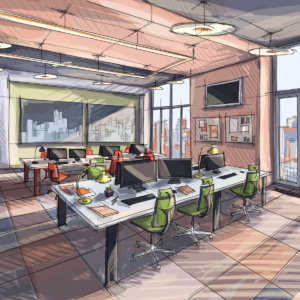How Office Seating Arrangements Can Boost the Bottom Line
One CEO believes where people sit is key to a company’s success.
Topics
“Goodness to a righteous person, leads to goodness to his neighbor.”
— Babylonian Talmud (300 A.D.)
I spent a gap year after high school living in Jerusalem and studying the Talmud. Throughout this historic work, there are references to the importance of “space” and the influence that a neighbor can have. From a young age, I’ve always focused on the significant impact of “location” in one’s life.
Recently, our next-door neighbors asked if we knew anyone looking for a house prior to putting their house on the market (not a bad strategy to avoid real estate commissions!). My wife and I, appreciating the heads-up, reached out to a few families we knew we wanted as neighbors. It ended up working out.
I have translated my belief in the importance of location — and the people in it — to my professional life as well, first while working in human resources and now as CEO of Investopedia. Specifically, I take a personal interest in seating arrangements. I believe that where people sit has a major impact on managerial and team effectiveness. It influences personal friendships, which lead to business relationships; builds stronger team behavior through collaboration; improves employee retention; and ultimately results in smarter decision-making.
I try to never micromanage, but this is one of the few areas where I do. Here’s how my approach works.
Execs Sit With Execs
Research on the importance of high-functioning executive teams to company performance has been conclusive. Too often, when leaders are asked to name their “team,” they list only their direct reports. Yet the most important team an executive is on is the senior leadership team.
Often, it is the silos between functions that result in a misalignment of company priorities and poor decisions. These silos typically result in a “political” environment where information is shared directly with the CEO rather than between executives. This is why it is critical that your leadership team sits together.
My eight-person executive team sits in an open-space environment. Execs with 20+ years of experience sit beside one another with no preferential seating over a college intern. There are no walls, no barriers. They hear what someone’s weekend plans are and can listen in on business conversations both formally and informally. Indeed, I have long believed that informal conversations are far more important in executive team building than formal (and far less productive) strategy meetings.
Function Over Form
The typical corporate structure calls for people with similar functions to sit together, building relationships with coworkers of similar backgrounds, careers, and interests. As a leader, you need to break this paradigm.
Many job functions have a strong basis for reporting into multiple areas, and it often isn’t clear where people should report. For example, marketing typically reports to a chief marketing officer, but sometimes reports into sales. Product could report into a head of strategy, a head of product, or a chief technology officer.
The best practice here is that individuals should sit near the function that you want them to collaborate with, not the function that they report into. For example, we made the mistake of having our social media team report into and sit next to our marketing department, since the goal of both functions was to drive users to our site. However, we were finding that there was an increasing disconnect between our social media team and our larger editorial staff.
We moved the social media team to sit within editorial. Relationships developed, team members started getting invited to larger editorial strategy meetings, and increasingly, there was a far greater alignment between our content and social media strategies.
Sit people outside their reporting function, and barriers between functions will melt away.
Ask, Don’t Tell
Investopedia has more than tripled its staff over the last couple of years to 140 employees, and we are now in our third (and hopefully last, for a while) home in midtown Manhattan. Before every move, we send a survey to employees that asks who they need to sit with to best achieve their goals, who will they learn most from, and who they do not want to sit near.
Involving employees is extremely important, as they will be spending more time with work neighbors than with their families. We shouldn’t force people to sit next to someone they’re not comfortable with.
When it comes to new hires, I send a personal message sharing my excitement for their joining (every CEO of a company with fewer than 500 employees should do this) and then send a note to HR and the hiring manager recommending where the new hire should sit and why. When there is disagreement, we’ll discuss the pros and cons of different arrangements.
Frequently, I have used seating to provide a development opportunity for a manager. For example, one of my execs is not sufficiently analytical, and I specifically asked that the new analyst sit next to that executive.
Where employees sit directly impacts their personal relationships, teamwork, work satisfaction, ability to learn from colleagues, and executive functioning. It matters. Don’t let your office seating chart be like a game of musical chairs. The music should stop with you.









